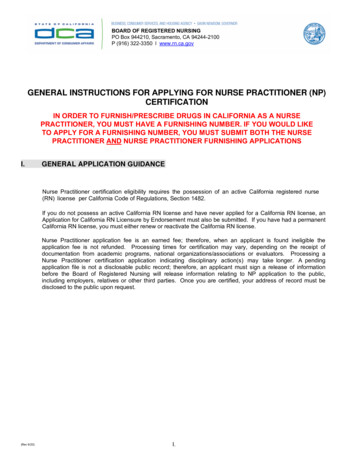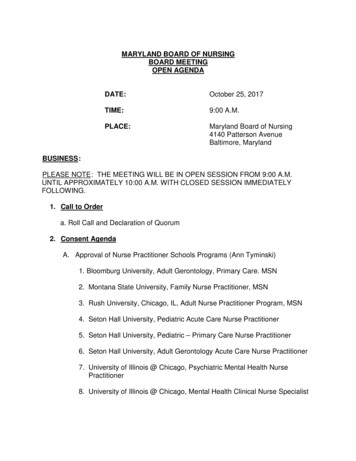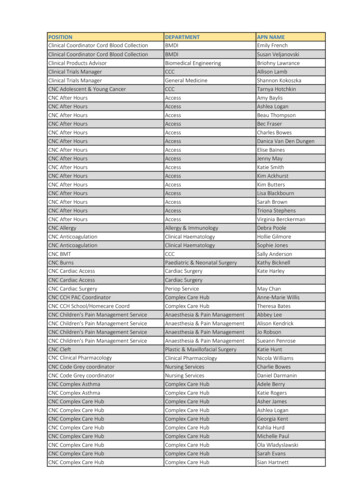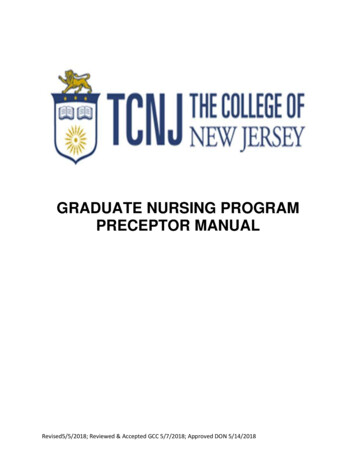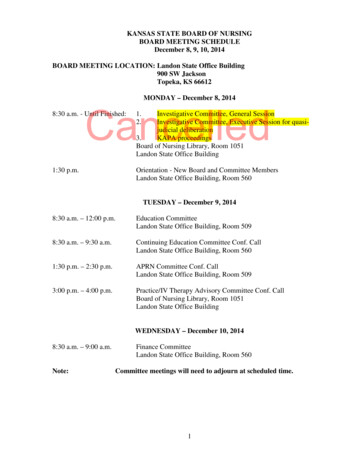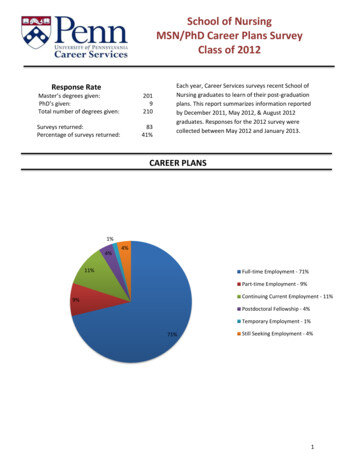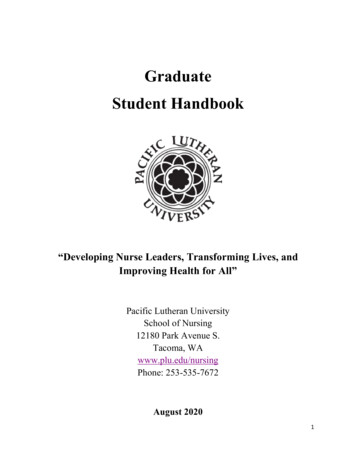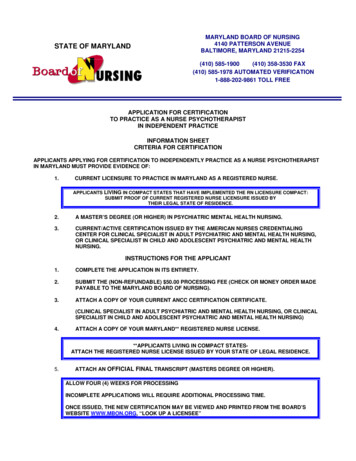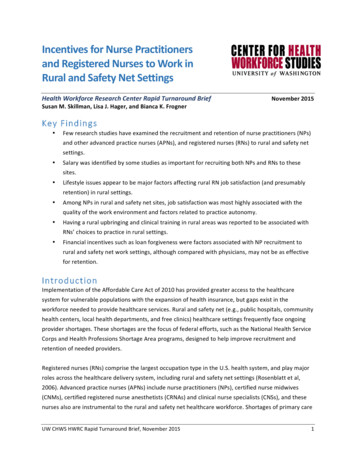
Transcription
Incentives for Nurse Practitionersand Registered Nurses to Work inRural and Safety Net SettingsHealth Workforce Research Center Rapid Turnaround BriefNovember 2015Susan M. Skillman, Lisa J. Hager, and Bianca K. FrognerKey Findings Few research studies have examined the recruitment and retention of nurse practitioners (NPs)and other advanced practice nurses (APNs), and registered nurses (RNs) to rural and safety netsettings. Salary was identified by some studies as important for recruiting both NPs and RNs to thesesites. Lifestyle issues appear to be major factors affecting rural RN job satisfaction (and presumablyretention) in rural settings. Among NPs in rural and safety net sites, job satisfaction was most highly associated with thequality of the work environment and factors related to practice autonomy. Having a rural upbringing and clinical training in rural areas was reported to be associated withRNs’ choices to practice in rural settings. Financial incentives such as loan forgiveness were factors associated with NP recruitment torural and safety net work settings, although compared with physicians, may not be as effectivefor retention.IntroductionImplementation of the Affordable Care Act of 2010 has provided greater access to the healthcaresystem for vulnerable populations with the expansion of health insurance, but gaps exist in theworkforce needed to provide healthcare services. Rural and safety net (e.g., public hospitals, communityhealth centers, local health departments, and free clinics) healthcare settings frequently face ongoingprovider shortages. These shortages are the focus of federal efforts, such as the National Health ServiceCorps and Health Professions Shortage Area programs, designed to help improve recruitment andretention of needed providers.Registered nurses (RNs) comprise the largest occupation type in the U.S. health system, and play majorroles across the healthcare delivery system, including rural and safety net settings (Rosenblatt et al,2006). Advanced practice nurses (APNs) include nurse practitioners (NPs), certified nurse midwives(CNMs), certified registered nurse anesthetists (CRNAs) and clinical nurse specialists (CNSs), and thesenurses also are instrumental to the rural and safety net healthcare workforce. Shortages of primary careUW CHWS HWRC Rapid Turnaround Brief, November 20151
and several key specialist physicians are widespread in rural and other underserved areas of the U.S.,and NPs and other APNs are frequently seen to be well-positioned to help meet these needs (Auerbachet al, 2013; Fairman et al, 2011; Institute of Medicine, 2011; Naylor and Kurtzman, 2010).Rural communities and healthcare safety net facilities have long faced difficulty recruiting and retainingskilled healthcare workers. While circumstances vary, these sites tend to be low resource environmentswith fewer professional development and training opportunities compared with urban communities.Still, rural communities and safety net facilities provide attractive healthcare opportunities for manyproviders. Identifying the factors that draw workers to these sites is key to effective health workforceplanning.In this Brief, we provide a summary of what is in the published literature (peer-review and gray) aroundthe following questions:1. What incentives work to attract RNs and NPs to rural areas for employment?2. What incentives encourage RNs and NPs to work for safety net providers?Overall we found limited published evidence addressing either question, though there tends to be moreliterature around the first question. In addition to discussing what is known about the recruitment andretention of RNs and NPs in rural areas and for safety net providers, we also draw from the literatureabout recruitment and retention of providers more generally for these settings.Evidence Related to Incentives for Nurses to Practice inRural and Safety Net SettingsRural settingsIn a study of graduates from 12 health professional programs (including NPs, CNMs and bachelor’sdegree RNs) in New Mexico, rural practice choice was associated with preference for smaller sizedcommunities and having a rural background, as well as access to loan forgiveness and rural trainingprograms (Daniels et al, 2007). Factors found to be associated with rural retention included ruralbackground, financial factors, and professional opportunities. The authors acknowledged limitations ofthe study, however, including small sample sizes for RNs and APNs, and a high proportion ofrespondents who had completed a rural practicum during their training which likely led to resultsheavily weighted by providers who were predisposed to be interested in rural practice.Community health center CEOs across the U.S. were asked in 2004 about barriers to recruiting RNs(Rosenblatt et al, 2006). Compared with respondents from urban clinics, higher percentages of ruralrespondents indicated that lack of spousal employment, lack of cultural activities, lack of housing, andpoor-quality schools in rural areas were barriers to recruiting RNs. Lower percentages of rural comparedwith urban respondents indicated that compensation and excessive workloads were barriers to RNrecruitment.UW CHWS HWRC Rapid Turnaround Brief, November 20152
Molinari and Monserud (2008) reported that among RNs employed in rural hospitals in the northwestU.S., those with the highest job satisfaction preferred rural lifestyles and had rural backgrounds. Theauthors suggested that, in addition to rural origins, flexible scheduling, recreation opportunities, climateand social activities influenced nurses’ job satisfaction and intention to stay in rural jobs.From analyses of the 2000 and 2004 National Sample Survey of RNs, Skillman et al in two studies (2006;2012) reported that rural RNs, compared with urban RNs, had less nursing education, were less likely towork in a hospital, and were more likely to work full-time and in a public/community health facility.Across a continuum of rural area types (large rural, small rural and isolated small rural) the more ruralthe residence of RNs, the lower their salaries. In addition, the more rural the RNs’ residence, the morelikely they were to commute to a larger rural or urban community for work. Rural RNs who commutedto jobs in less rural areas had higher salaries than those who lived and worked in the same rural areatype. This suggests that attracting and retaining RNs in rural communities is affected by salary levels.RN residency programs are a recent introduction designed to reduce the high rates of turnover amongRNs in their first year of practice, which is reported to be even higher in rural settings than in urban(Bratt et al, 2014). Bratt et al’s longitudinal study of 12-month RN hospital residency programs in ruraland urban areas of the U.S. compared outcomes of urban and rural nurses who completed residencyprograms. They found that the rural nurses had lower levels of work-related stress compared with theirurban counterparts, possibly due to a slower pace of work, less patient acuity, and greater autonomy inthe rural sites. This study did not compare newly-practicing RNs completing residencies to those who didnot complete a residency. Nonetheless, the study suggests that rural RN residencies might be effectivemethods to promote rural retention, and merits further study.In an analysis of the 2012 National Sample Survey of Nurse Practitioners, Spetz et al (in press) found thatthere were fewer NPs per capita in rural areas, but a larger proportion were in primary care. Comparingurban and rural NPs in primary care, the authors found that salaries were similar (without adjusting forcost of living), and a higher share of rural NPs worked in states without physician oversightrequirements. Compared with urban NPs, rural NPs more often reported they were fully using their NPskills, practicing to the fullest extent of the legal scope of practice, satisfied with their work, andplanning to stay in their jobs despite working more hours and seeing more patients. The study was notable to identify if rural-practicing NPs grew up in rural communities or if they had initiated their ruralpractice with tuition reimbursement or other incentives for rural practice. Based on their findings, Spetzet al conclude that more NPs might consider rural practice if the positive characteristics, includinggreater practice autonomy and comparable salaries, were used as recruiting tools.UW CHWS HWRC Rapid Turnaround Brief, November 20153
Safety net settingsLittle research is available addressing recruitment and retention incentives for RNs specifically in safetynet sites. The research by Rosenblatt et al (2006) cited above describes barriers to recruiting RNs inurban compared with rural community health centers. There are more general studies, however, onissues related to recruiting and retaining RNs which are likely also to be relevant to safety net settings.Some of these studies are mentioned in the Discussion section.The Multi-State National Health Service Corps (NHSC) Retention Collaborative examined cliniciancharacteristics, their practices and their service experiences associated with retention in their NHSCservice sites (safety net facilities) (Pathman et al, 2012). A variety of clinicians were studied, includingphysicians, NPs, physician assistants, mental health practitioners and midwives. A general finding fromthe study was that loan repayment programs were more effective than scholarship programs forretention of the clinicians to the NHSC service site. Physicians and mental health practitionersanticipated remaining longer in their service sites than did NPs. Clinicians who were age 30 and older,had children, and were not racial/ethnic minorities expected to stay in the service site longer, as didclinicians who were serving in their home states or where they completed clinical training. TheCollaborative’s recommendations to NHSC programs and states were that loan repayment programswere good public investments with payoffs that extended beyond NHSC participants’ service periods fordisciplines such as physicians and mental health practitioners. For some other disciplines, loanrepayment may not be cost-effective; among all occupations studied, NPs had the lowest odds ofanticipated retention compared with physicians. This study measured anticipated retention at theservice site, leaving opportunity for further study to measure actual retention in the service site as wellas to see if NHSC participants continue to work in other safety net sites later in their careers.A survey in federally-funded Title X Family Planning Clinics found APNs’ intentions to remain in theirpositions were associated with having greater family responsibilities, and greater satisfaction wasassociated with less routinization (i.e., the degree to which a job is repetitive). More integration (i.e.,having close friends within the organization), and a greater sense of distributive justice (i.e., how rate ofpay also is related to the effort put into the job, and compared with APNs in other community settings)(Cheng et al, 2014).Discussion and ConclusionsWhile they are closely related, workforce recruitment and retention have somewhat different goals andare influenced by somewhat different factors. In addition, definitions are important in measuring theconcepts. In a review of literature from multiple countries, including the U.S., Bärnighausen and Bloom(2009) concluded that “ financial incentive programs have placed substantial numbers of healthworkers in underserved areas and [program] participants are more likely than non-participants to workin underserved areas in the long run, even though they are less likely to remain at the site of originalUW CHWS HWRC Rapid Turnaround Brief, November 20154
placement.” Retention, defined as continuing employment at the specific site where a worker isoriginally recruited, may be the goal of a health facility administrator. Yet if a worker moves from onerural or safety net site to another, the overall target populations will still benefit and another form of“retention” will have been achieved.Financial factors are often a primary consideration in both job satisfaction measurement andrecruitment strategies. Misfeldt et al (2014), in a review of research across multiple countries, foundthat compensation, scholarship programs, benefits and loan repayment are important in healthworkforce recruitment but less relevant for retention. Non-financial incentives including high qualitywork environment and opportunities for professional growth may be better for retention than financialfactors alone. Donoghue and Castle (2007) suggested that the economic environment of a community isimportant for successful retention. Local schools, job opportunities for spouses, daycare/eldercareoptions as well as recreational and cultural offerings are factors that may determine whether nurseswith changing family needs decide to stay in their current jobs rather than seek employment elsewhere.Other possibilities for improving retention were opportunities for collaboration, emphasis on work-lifebalance (e.g. child care, flexibility) and workload adjustments.With regard to education and clinical training, studies included in this Brief have emphasized theimportance of rural upbringing and/or rural-based educational experiences for recruiting and retainingclinicians, including nurses, in rural settings. Rural topics presented as part of regular nursing curricula,as well as clinical rotations at rural sites, could help students better understand their options foremployment, including those in rural and urban underserved areas, and presumably provide somepreparation for rural jobs.Many of the articles referenced here may not reflect the most current nurse workforce issues. Relatedresearch conducted since the 2008 recession and the advent of the Affordable Care Act is just becomingavailable. Nurses’ personal preferences for job location and setting, however, may not be demonstrablydifferent than a decade ago, barring recent specific impacts on individual communities’ economicoutlooks, clinic settings’ funding sources, and unemployment situations. But more research wouldclearly be helpful to inform employers, policymakers, and community health planners about effectivenurse recruitment and retention strategies, especially in the context of the nation’s rapidly changinghealthcare landscape.Few published articles describe research directly addressing factors associated with job satisfaction,recruitment and retention among NPs and RNs in safety net facilities, although there is somewhat moreavailable on these topics with regard to rural settings. In light of this paucity of research, studies fromother settings and other occupations need to be considered when making decisions about approachesto rural and safety net workforce policy.UW CHWS HWRC Rapid Turnaround Brief, November 20155
MethodsFor this Brief, the authors carried out searches of scholarly publications and lay literature to identifyresearch addressing the study questions. The databases PubMed and CINAHL were employed usingsearch terms as registered nurse, advanced practice nurse, nurse practitioner, rural, community healthcenter, FQHC, safety net, recruitment, retention, job satisfaction and staff turnover. The Google searchengine was used to conduct a comparable examination of the “gray” literature using similar searchterms. The searches were limited to studies conducted in the U.S., although some publications thatinvolved reviews of the literature from multiple countries including U.S. have been referenced.ReferencesAuerbach DI, Chen PG, Friedberg MW, Reid R, Lau C, Buerhaus PI, Mehrotra A. Nurse-managedhealth centers and patient-centered medical homes could mitigate expected primary care physicianshortage. Health Aff (Millwood). 2013 Nov;32(11):1933-1941. doi:10.1377/hlthaff.2013.0596.Bärnighausen T, Bloom DE. Financial incentives for return of service in underserved areas: a systematicreview. BMC Health Serv Res. 2009 May 29;9:86. doi:10.1186/1472-6963-9-86.Bratt MM, Baernholdt M, Pruszynski J. Are rural and urban newly licensed nurses different? Alongitudinal study of a nurse residency programme. J Nurs Manag. 2014 83.x. Epub 2012 Nov 2.Cheng AL, Kelly PJ, Carlson K, Witt J. The intention of advanced practice registered nurses to remainin positions at family planning clinics serving low-income women. J Prof Nurs. 2014 JanFeb;30(1):72-79. doi:10.1016/j.profnurs.2012.12.013. Epub 2014 Jan 2.Daniels ZM, Vanleit BJ, Skipper BJ, Sanders, ML, Rhyne, RL. Factors in recruiting and retraining healthprofessionals for rural practice. J Rural Health. 2007 Winter;23(1):62-71.Donoghue C, Castle NG. Organizational and environmental effects on voluntary and involuntaryturnover. Health Care Manage Rev. 2007 Oct-Dec;32(4):360-369.Fairman JA, Rowe JW, Hassmiller S, Shalala DE. Broadening the scope of nursing practice. N Engl J Med.2011 Jan 20;364(3):193-196. doi:10.1056/NEJMp1012121. Epub 2010 Dec 15.Institute of Medicine. The Future of Nursing: Leading Change, Advancing Health. Washington DC:National Academy of Sciences. Retrieved April 28, 2015 fromhttp://www.nap.edu/openbook.php?record id 12956Misfeldt R, Linder J, Lait J, Hepp S, Armitage G, Jackson K, Suter E. Incentives for improving humanresource outcomes in health care: overview of reviews. J Health Serv Res Policy. 2014 Jan;19(1):5261. doi:10.1177/1355819613505746. Epub 2013 Oct 29.Molinari DL, Monserud MA. Rural nurse job satisfaction. Rural Remote Health. 2008 Oct-Dec;8(4):1055.Epub 2008 Dec 3.Naylor MD, Kurtzman ET. The role of nurse practitioners in reinventing primary care. Health Affairs.2010 29(5), 893-899. doi:10.1377/hlthaff.2010.0440UW CHWS HWRC Rapid Turnaround Brief, November 20156
Pathman D et al. (November 2012) Cecil G. Sheps Center for Health Services Research, the University ofNorth Carolina at Chapel Hill. Findings of the first year retention survey of the Multi-State/NHSCRetention Collaborative. t.pdf Sep;34(3):190-200. doi:10.1097/NAQ.0b013e3181e702b7.Rosenblatt RA, Andrilla CH, Curtin T, Hart LG. Shortages of medical personnel at community healthcenters: implications for planned expansion. JAMA. 2006 Mar 1;295(9):1042-1049.Skillman SM, Palazzo L, Doescher MP, Butterfield P. Characteristics of rural RNs who live and work indifferent communities. Final Report #133. Seattle, WA: WWAMI Center for Health WorkforceStudies, University of Washington; 2012.Skillman SM, Palazzo L, Keepnews D, Hart LG. Characteristics of registered nurses in rural versus urbanareas: implications for strategies to alleviate nursing shortages in the United States. J. Rural Health.2006 Spring;22(2):151-7.Spetz J, Skillman SM, Andrilla CHA. Nurse practitioner autonomy and satisfaction in rural settings.Medical Care Research and Review (in press).Contact:Susan M. Skillman, Deputy DirectorCenter for Health Workforce StudiesUniversity of Washington, Seattle, WAskillman@uw.edu206 543-3557.UW CHWS HWRC Rapid Turnaround Brief, November 20157
and social activities influenced nurses' job satisfaction and intention to stay in rural jobs. From analyses of the 2000 and 2004 National Sample Survey of RNs, Skillman et al in two studies (2006; 2012) reported that rural RNs, compared with urban RNs, had less nursing education, were less likely to

